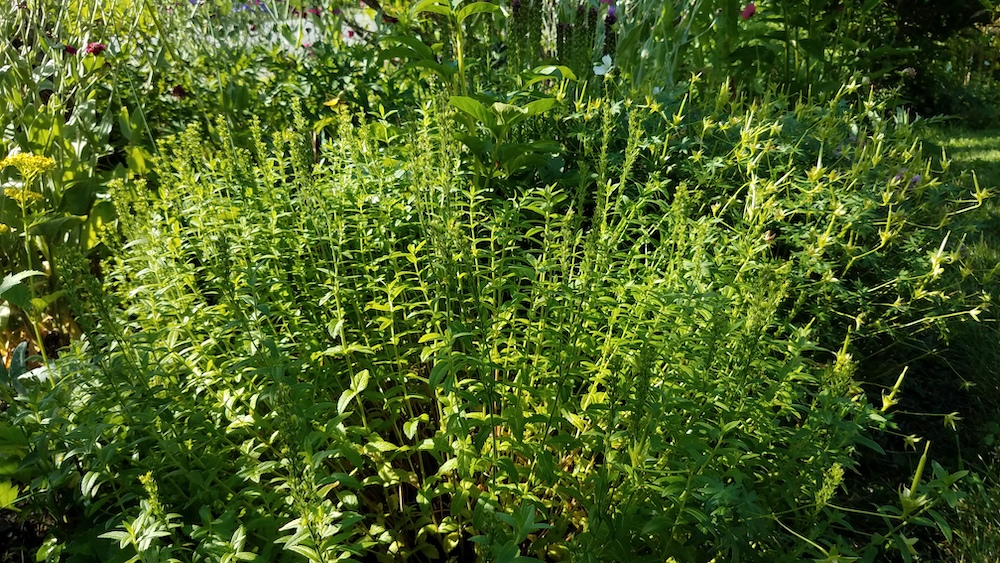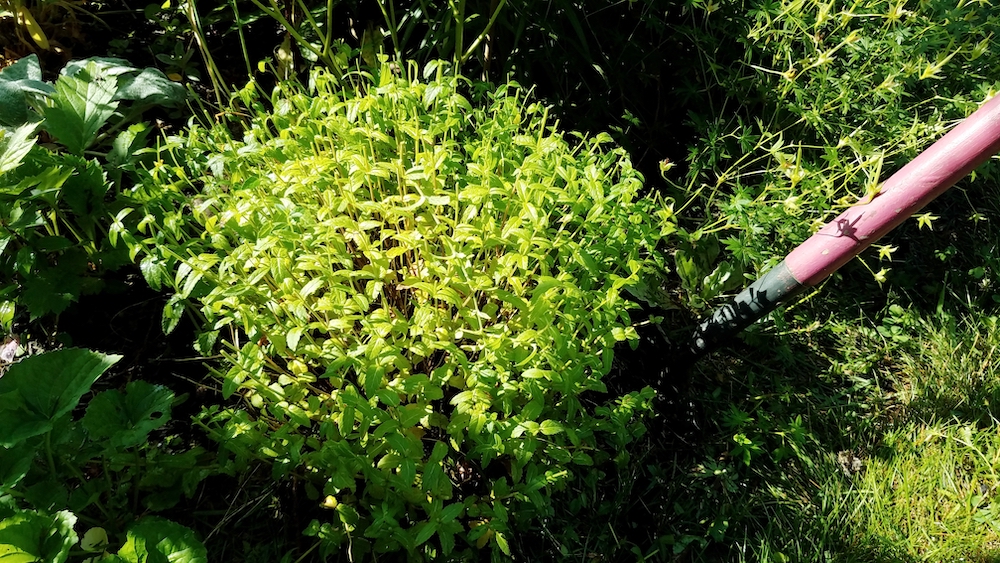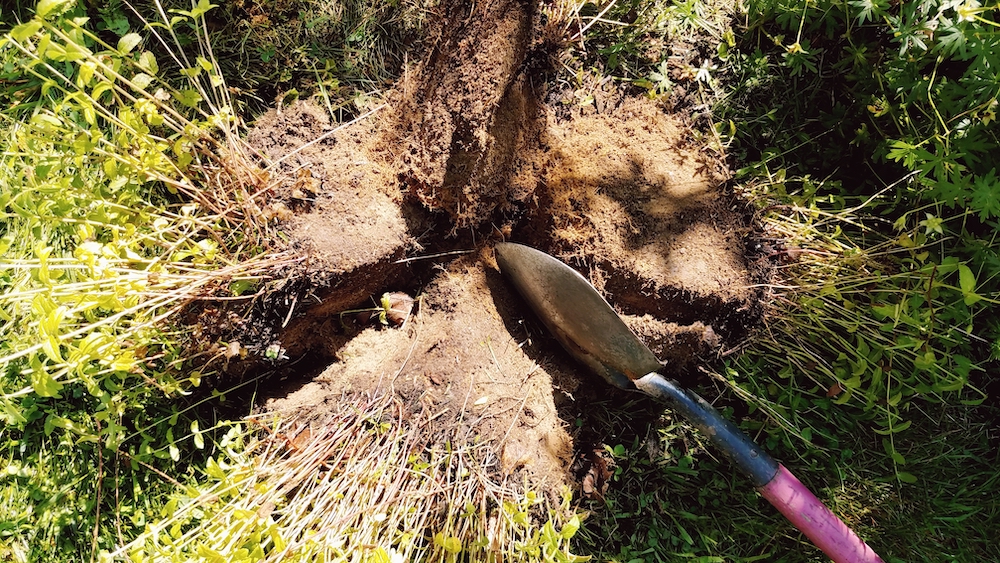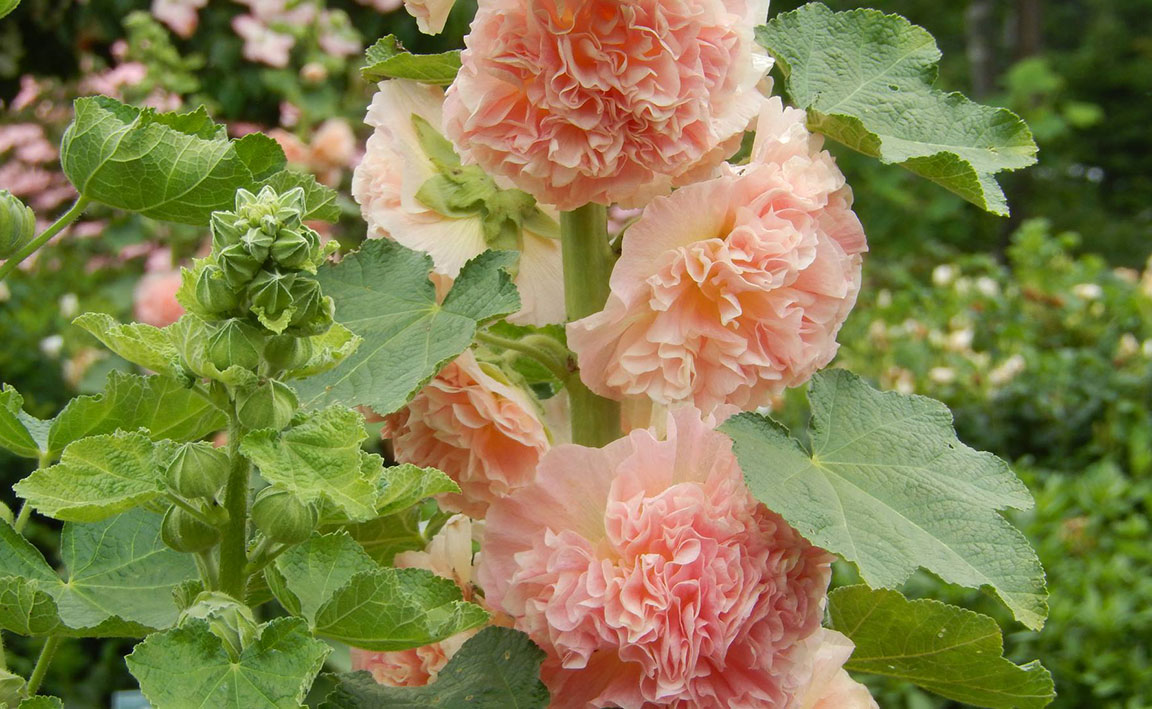
Maine Home Garden News — August 2019
- August Is the Month to . . .
- How to Divide Perennials in Late Summer and Early Fall
- The American Pelecinid Wasp
- False Anemone
- Climate Impacts on Maine Wild Blueberry Farms
- The University of Maine 4-H Center at Bryant Pond is Recruiting
- Volunteer Spotlight: Growing Beauty and History in Somerset County
- News Release: USDA Declares August Tree Check Month: Urges Public To Look For Invasive Asian Longhorned Beetle
- Food & Nutrition: Drying Your Garlic
August Is the Month to . . .
By Kate Garland, Horticulturist, UMaine Extension Penobscot County
- Educate your friends about invasive plants. Pointing out an invasive plant in a friend’s yard is a lot like letting them know they have food in their teeth. It’s an uncomfortable conversation, but best to just do it (in a kind and positive way) and get it over with. Many homeowners unknowingly have invasive plants in their landscape and, while it’s not illegal to have them, it’s best to make efforts to eradicate as many as possible to minimize risks to our natural landscapes. Prepare to offer suggestions for alternatives or direct them to Extension for advice. Hopefully they’ll still invite you back to their next barbecue.
- Step away from the pesticides until your garden problems are properly diagnosed. Tis’ the season for powdery mildew, blight, leaf spots, insect damage, and more. Once fungal pathogen symptoms are visible on plant tissue it’s almost always too late to “cure” the plant with a fungicide and it may not be necessary to treat the plant anyway. Insecticides are often only effective during a narrow window of time during an insect’s life cycle. Avoid unnecessary and ineffective applications of pesticides by reaching out to your local Extension office to properly diagnose and learn how to manage the problem.
- Harvest frequently. Beans, peas, zucchini, and summer squash are all examples of crops that require harvests more than once a week. If left unchecked, you risk having tough, watery or oversized low-quality fruit.
- Preserve your harvest! UMaine food safety experts have compiled many excellent resources for the home gardener. Notable resources include: refrigerator pickles, herbal vinegars, and over a dozen “how-to” videos. If you’re pressure canning, have your dial gauge checked annually for accuracy.
- Share your harvest! Join the Maine Harvest for Hunger team as we celebrate our 20th year and the milestone of donating over 3 million pounds for fresh produce to neighbors in need. Contact your area food pantry to see if and when they can accept donations of fresh produce or reach out to your local Extension office to find a donation site.
- Take advantage of sales and inspiration at local nurseries. It’s perfectly fine to install new plants this time of year. Simply provide 1” of water per week to get them established and they’ll do fine.
- Plant a fall cover crop, such as oats, in areas that have been harvested clean OR plant short-season crops such as radish, salad turnips, spinach, pea shoots, lettuce, and other assorted baby leaf greens.
- Practice low-input lawn care methods. Keep mower blades set high and leave clippings behind. Apply beneficial nematodes (PDF) in late August (timing is very important) to keep white grubs in check and reseed bare spots to reduce weed pressure. Have your soil tested to determine whether any adjustments to pH or fertility need to be made. This is also a good time of year to get new lawns established from seed.
- Don’t let weeds go to seed. Weed seed rain (the result of weeds developing and dropping seeds onto the soil) from a single plant can potentially add thousands of seeds to the soil seed “bank.” The seed of some species can remain viable in the soil seed bank for 30-40 years. Reducing weed seed rain can have a significant impact on long- and short-term weed pressure.
- Remove spent flowers on annual and perennial plants to improve overall plant health and increase the likelihood of rebloom.
- Gather supplies for season extension. Winter is coming . . . there, I said it. Instead of denying the inevitable, purchase or dig out your row cover and hoops to protect low-growing crops. Don’t let an early frost steal precious days of great growing conditions and even better yields from your crops this fall. Learn more.
-
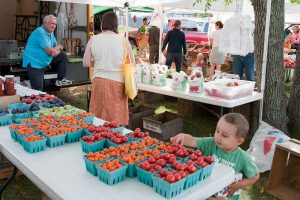
© Edwin RemsbergPhoto by Edwin Remsberg Take advantage of the bounty at your local farmers’ market and learn about great programs such Maine Harvest Bucks, end of market gleaning, and Senior Farm Share. If you have a free day and are looking for a new market, the Maine Federation of Farmers’ Markets even has organized a list of markets by the day of the week they’re open.
- Enjoy the fair season! Maine agricultural fairs are fun for the whole family. Be sure to say hello and support our 4-H friends who work very hard to share their knowledge with the public at these events. See full listing of dates and locations here.
How to Divide Perennials in Late Summer and Early Fall
By Liz Stanley, Horticulture Program Coordinator, UMaine Extension Knox, Lincoln, and Waldo Counties
Dividing perennials can rejuvenate plants and make them perform better next season. The bonus? You end up with extra plants to add to your garden or give away.
Although many plants can be divided in early spring, now is often the best time for plants that bloomed early. By late summer, you can also tell which plants haven’t flowered very well, or have hollow centers and weak foliage.
Some of the best candidates for dividing at this time of year are peonies, veronica, Siberian iris, trollius, oriental poppy, and bearded iris. When you make more plants, think about making groupings of a single variety for a more natural “drift” effect.
Start by watering your plant one day before dividing. Ideally, divide on an overcast day to avoid desiccation and transplant shock.
For an in-depth publication on dividing perennials and a list of which ones to do in different seasons, visit the University of Minnesota Extension.
- Photo 1. This Veronica ‘Shirley Blue’ is old and crowded in a jungle of other plants.
- Photo 2. Remove spent flowers and weeds, and dig generously around the plant with a sharp shovel or fork.
- Photo 3. Separate the clump into sections using a shovel, knife or two forks back-to-back.
- Photo 4. Loosen roots and inspect for insects, diseases, damage or invasive plants (like goutweed). Replant or pot up as soon as possible.
The American Pelecinid Wasp
By Leala Machesney, Horticulture Graduate Student, The University of Arkansas
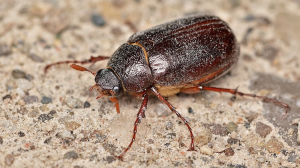
June bugs are a familiar site this time of year. Also called June beetles or May bugs, these drab brown beetles belong to the genus Phyllophaga and have voracious appetites. The larvae, colloquially called grubs, will feed heavily on the roots of turfgrass and plants in pastures and agricultural fields. Not only can this feeding damage turf and crops, but birds and small mammals will turn over carefully-manicured lawns once they find sizeable populations of white grubs. Adult beetles emerge from the safety of the soil in early summer and proceed to consume many species of crops as well as deciduous trees and shrubs. Luckily, there are several species of insects that prey on June bugs. One of these species is the American pelecinid wasp (Pelecinus polyturator).
The American pelecinid wasp is the only member of its genus found in North Americas, although it has a large range extending from Argentina to Canada. It would be difficult to mistake the female American pelecinid wasp for any other insect. This glossy black wasp is often an impressive 2 inches in length. Most of that length is comprised solely of a long, thin abdomen. While June bug grubs are nestled in the soil, feeding on roots, and biding their time until pupation, they are vulnerable to attack from the American pelecinid wasp. A female wasp will stick her abdomen deep into the soil until she finds the fleshy body of a grub. Then, she deposits her eggs in, or on, the grub. These eggs will eventually hatch and the larvae will burrow into the June bug, then begin to rapidly feed. Many wasp species practice a similar reproductive strategy, called parasitoidism. While a parasite spends the entirety or majority of its life cycle inside a host and benefits from keeping the host alive, parasitoids spend only a portion of their life cycle inside a host. Whether during feeding or emergence, parasitoids kill their host organisms. Once American pelecinid wasp larvae kill their hosts, they will pupate in the soil and emerge as adults and feed on nearby nectar.
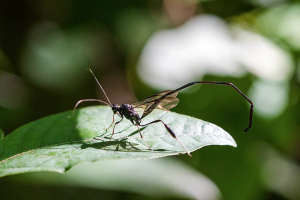
Male pelecinid wasps are much smaller than their female counterparts. This is because they lack the fine, whip-like abdomen of the female wasp. But if you see an American pelecinid wasp in Maine, you’re almost certainly not seeing a male wasp. There are very few male American pelecinid wasps in the United States compared to female American pelecinid wasps. This may seem to put the American pelecinid wasp at a reproductive disadvantage, but female wasps have evolved a unique strategy to circumvent this highly uneven sex ratio: a form of asexual reproduction called thelytoky. Northern female American pelecinid wasps lay unfertilized eggs that develop into more female wasps, each a clone of its parent. Asexual reproduction isn’t an uncommon phenomenon in insects. For example, aphids depend on asexual reproduction to rapidly increase their populations, while queen honey bees can lay fertilized eggs that develop into female worker bees or unfertilized eggs that develop into male drones. What is unusual is that southern populations of American pelecinid wasp reproduce sexually and male wasps are present in much greater numbers. There is still uncertainty over when female American pelecinid wasps adapted to a lack of male wasps, as well as the causes for the scarcity of male wasps in northern climates.
Further Reading
- Proceedings of the Entomological Society of Manitoba, Volume 64, 2008: On the occurrence of Pelecinus polyturator (Hymenoptera: Pelecinidae) in Manitoba, Canada (PDF)
- Lost episodes: “My, what a long tail you have little wasp. The American pelecinid wasp, Pelecinus polyturator,” Bug of the Week
- American Pelecinid Wasp (Family Pelecinidae), University of Wisconsin Milwaukee Field Station
False Anemone (Anemonopsis macrophylla)
By Leala Machesney, Horticulture Master’s Student, The University of Arkansas
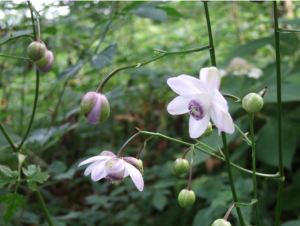
Many plants native to Japan also grow well in Maine. This can be attributed to Maine and northern Japan sharing the same Köppen climate classification: humid continental. Humid continental climates are characterized by warm humid summers and bitterly cold winters. Forests, both deciduous and evergreen, are typical in these regions. As a result, there is a great diversity of herbaceous plants adapted to woodlands in humid continental climates. The false anemone (Anemonopsis macrophylla) is one such plant. False anemone can be found in the north of Japan’s main island, Honshu. It thrives in the moist, neutral or acid soils composed of clay or loam typical of the area. The forest environment favored by false anemone protects plants from strong, desiccating winds and harsh sun that would burn the plant’s foliage. In Maine, where soils tend to be acidic and many homeowners have abundant access to both full and partial shade, the false anemone grows with relative ease. Because false anemone is hardy from zones 4 to 7, only growers in the coldest regions of Maine may have difficulty with this plant.
False anemone are prized for their graceful nodding flowers. The pale purple flowers open in late summer, and do bare a resemblance to anemones. This is unsurprising; both anemone and false anemone belong to the plant family Ranunculaceae, a family that includes treasured horticultural plants like columbine and clematis. But false anemone is much more closely related to plants in the genus Actaea than true anemones. Both Anemonopsis and Actaea belong to the Cimicifugeae, a tribe in Ranunculaceae. Looking at both genera, the relation is obvious. Plants in these genera have very similar foliage and an inflorescence that extends far above that foliage.
If you’d like to add false anemone to your garden, the best course of action would be to buy plants from a nursery. Seeds need to be exposed to moisture and chilling before germination occurs, and even after germination, plants are slow to reach their mature height of approximately 75 centimeters. Additionally, plants won’t form true leaves in the first year. Instead, for the first season of growth, false anemone has only cotyledons. The cotyledons are short-lived foliage present in many plants that are the first leaves to emerge after seed germination. They often look drastically different than the true leaves that will form as plants mature. If you’ve ever grown or purchased alfalfa sprouts the leaves present on these plants are a good example of cotyledons. It’s during the second year of growth that false anemone grows true leaves, but flowers only form on the plant five years after initial seed germination. If you know of someone with a healthy colony of false anemone, it may be worth asking if you could carefully dig up a clump of the plant and take a division. The original clump shouldn’t be negatively affected, and you won’t need to wait for the many years required for false anemone to reach full maturity.
Further Reading
- Armitage, Allan (2008). Herbaceous Perennial Plants. Stipes Publishing. p. 99. ISBN 978-1-58874-776-1.
- Phillips, Roger and Martin Rix (1991). The Random House Book of Perennials. Volume 2: Late Perennials. Random House, New York. ISBN 0-679-73798-7.
Climate Impacts on Maine Wild Blueberry Farms
Interview with David Yarborough, PhD, Sonja Birthisel and Erin Roche
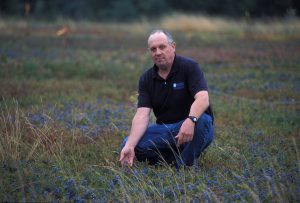
To better understand the impacts of climate change on blueberry farms, we asked UMaine Cooperative Extension’s David Yarborough* to reflect on his 40 years of experience advising Maine growers.
David has noticed changes in weather patterns during his career, including “both an earlier spring and a later fall” leading to a longer growing season, “more erratic frosts and freezes,” and the drought-inducing combination of “higher summer temperatures and less summer precipitation.” David suggests that emerging management issues related to these changes include the need for irrigation in crop fields, and new diseases and insect pests that can impact blueberry yields. Additionally, in relation to human health he notes that “ticks have also spread into wild blueberry fields and diseases they vector such as Lyme can cause serious diseases.” Here you can read David’s full interview.
This is part two in a series of Specialist Interviews the Maine Climate and Agriculture Network (MECAN) is collecting in order to share perspectives on climate change from different agricultural sectors in Maine. You can find out more about MECAN on our website.
*David retired from Cooperative Extension in the Spring of 2019.
The University of Maine 4-H Center at Bryant Pond is Recruiting Teens
The University of Maine 4-H Center at Bryant Pond is recruiting teens to participate in an Early College (three UMaine credits) course in outdoor leadership. The course, Outdoor and Adventure Skills (KPE 265), is available free of charge to any Maine residents who are rising 10th – 12th graders and is scheduled for mornings from July 29 – August 16. Download the brochure (PDF) for more information.
Volunteer Spotlight: Growing Beauty and History in Somerset County
By Kathy Hopkins, Extension Educator, UMaine Extension Somerset County
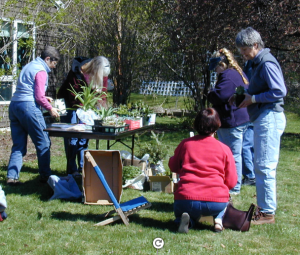
This Master Gardener Volunteer’s diverse and exceptional projects began in the spring of 2002 when Patricia Horine enrolled in the Somerset County Master Gardener Volunteer training in Skowhegan. One of her first ideas for a volunteer project with fellow MGV trainee, Sarah Carpenter, was to organize a “Plant Swap” for people in the county and surrounding area. Why a swap and not a sale? The goal was to provide gardening knowledge and assistance for low income gardeners who might not otherwise have access to a variety of plant material for their gardens. The requirements of the swap are simple. Bring a plant and swap for a different plant. The plants can be ornamentals, vegetables, trees or shrubs. The only requirement is that plants have to be healthy and labeled with the correct scientific name. Patricia, Sarah, and new Master Gardener Volunteers have always been on hand to help determine scientific names and to key out unknown specimens. The Plant Swap has been an annual event for 16 years and is looked forward to by the horticultural community in Somerset County each year. The Master Gardener Volunteers have benefited from this spring opportunity over the years by putting their botanical knowledge to use in their local community and informally sharing their plant knowledge with friends and neighbors.
Patricia continued her horticultural education by taking a floral design class at the University of Maine and became a Certified Landscape Designer through a series of classes offered by the Garden Club Federation of Maine. She used that knowledge to research, design, and install heirloom gardens at the Skowhegan History House. These gardens serve as a rich resource for those interested in antique ornamental varieties and their uses in historical gardens. She wrote and received a grant to create and install an educational kiosk which houses a plant material reference guide for the garden. She and her excited volunteers have increased the borders and specimens around the History House over the years to include new heirloom specimen plants. This educational and beautiful project has served as an ongoing volunteer and learning opportunity for Somerset Master Gardener Volunteers over the years.
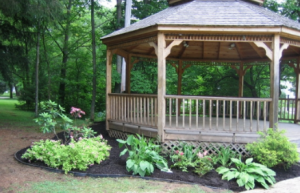
She also used her expanding horticultural knowledge to redesign both the gazebo garden at Coburn Park and the downtown Pocket Park, which are enjoyed both by townspeople and travelers passing through town. She volunteered on the Design Committee for Main Street Skowhegan and authored the “Green Space” section of a Federal grant the town applied for and received to redesign and implement changes in the downtown municipal parking lot.
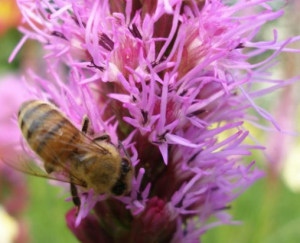
Next, Patricia turned her attention to beautifying the otherwise drab entrance to downtown in Skowhegan as one drives west on Route 2. This triangular traffic island garden also serves as a pedestrian pathway across the busy intersection of Route 2, Court, and Commercial Streets. It gives pedestrians a safe and beautiful place to pause while waiting to cross busy streets and access downtown businesses. The garden was designed to change with the seasons and in December, the town erects a lighted tree as a welcome to the business district.
 Patricia regularly volunteers over 300 hours a year and has used her energy and knowledge to improve the landscapes in Skowhegan. Her ability to bring people together around a common community goal has benefited both the town of Skowhegan and area residents. Since Skowhegan is the gateway to the upper Kennebec valley and to an increasingly popular rafting industry and the town annually hosts the Kneading Conference, bringing visitors to Maine from many other states and continents, her work has provided educational resources to visitors from near and far.
Patricia regularly volunteers over 300 hours a year and has used her energy and knowledge to improve the landscapes in Skowhegan. Her ability to bring people together around a common community goal has benefited both the town of Skowhegan and area residents. Since Skowhegan is the gateway to the upper Kennebec valley and to an increasingly popular rafting industry and the town annually hosts the Kneading Conference, bringing visitors to Maine from many other states and continents, her work has provided educational resources to visitors from near and far.
According to Patricia, “I have had the privilege of recruiting and working with a number of community volunteers over the years, folks who show up and help with the maintenance needed for the History House Heirloom Gardens and the Downtown Triangle Garden. The success of these gardens hinges on these volunteers!” The success of these gardens also hinges on the vision that Patricia had for her community. Patricia’s tireless work to improve Skowhegan and to build networks through the MGV program, volunteers, and history buffs has enabled Skowhegan to build a positive image of a town and region with much to offer. Thank you, Patricia!
News Release: USDA Declares August Tree Check Month; Urges Public To Look For Invasive Asian Longhorned Beetle
WASHINGTON, July 23, 2019 — August is the height of summer, and it is also the best time to spot the Asian longhorned beetle (ALB) as it starts to emerge from trees. The U.S. Department of Agriculture (USDA) is asking the public to take five minutes to step outside and report any signs of this invasive pest. Checking trees for the beetle will help residents protect their own trees and better direct USDA’s efforts to eradicate this beetle from the United States.
“It’s important to look for signs of the beetle now, because it’s slow to spread during the early stages of an infestation,” said Josie Ryan, APHIS’ National Operations Manager for the ALB Eradication Program. “With the public’s help, we can target new areas where it has spread and provide a better chance of quickly containing it.”
The Asian longhorned beetle feeds on a wide variety of popular hardwood trees, including maple, birch, elm, willow, ash and poplar. It has already led to the loss of more than 180,000 trees. Active infestations are being fought in three areas of the country: Worcester County, MA, Long Island, NY (Nassau and Suffolk Counties), and Clermont County, Ohio.
“Homeowners need to know that infested trees do not recover and will eventually die, becoming safety hazards,” warned Ryan. “USDA removes infested trees as soon as possible because they can drop branches and even fall, especially during storms, and this keeps the pest from spreading to nearby healthy trees.”
The Asian longhorned beetle has distinctive markings that are easy to recognize:
- Antennae that are longer than the insect’s body with black and white bands.
- A shiny, jet-black body with white spots, about 1” to 1 ½” long.
- Six legs and feet, possibly bluish-colored.
Signs of infestation include:
- Round exit holes in tree trunks and branches about the size of a dime or smaller.
- Shallow oval or round scars in the bark where the adult beetle chewed an egg site.
- Sawdust-like material called frass, laying on the ground around the tree or in the branches.
- Dead branches or limbs falling from an otherwise healthy-looking tree.
After seeing signs of the beetle:
- Make note of what was found and where. Take a photo, if possible.
- Try to capture the insect, place in a container, and freeze it. This will preserve it for easier identification.
- Report findings by calling 1.866.702.9938 or completing an online form at Asian Longhorned Beetle (ALB).
It is possible to eliminate this pest and USDA has been successfully doing so in several areas. Most recently, the agency declared Stonelick and Batavia Townships in Ohio to be free of the Asian longhorned beetle. We also eradicated the beetle from Illinois, New Jersey, Boston, MA, and parts of New York. The New York City boroughs of Brooklyn and Queens are in the final stages of eradication.
For more information about the Asian longhorned beetle, other ways to keep it from spreading—such as not moving firewood—and eradication program activities, visit Asian Longhorned Beetle (ALB). For local inquiries or to speak to your State Plant Health Director, call 1.866.702.9938.
Contact:
Rhonda Santos, 508.852.8044
rhonda.j.santos@usda.gov
Suzanne Bond, 301.851.4070
suzanne.m.bond@usda.gov
Food & Nutrition: Drying Your Garlic Crop
By Dave Fuller, UMaine Cooperative Extension Agriculture and Non-Timber Forest Products Professional, Franklin County
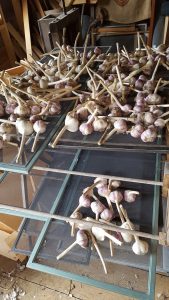 Now that you’ve harvested your garlic, the process of drying begins. Improperly dried garlic can result in issues with mold, mites or possibly the loss of your crop. Follow these tips to maintain bulb quality and lengthen the storage life of your treasured garlic.
Now that you’ve harvested your garlic, the process of drying begins. Improperly dried garlic can result in issues with mold, mites or possibly the loss of your crop. Follow these tips to maintain bulb quality and lengthen the storage life of your treasured garlic.
Start by removing the tops of harvested garlic down to approximately 6” from the top of the bulb. Dead tops do not hasten the drying of bulbs. This 6” length of stem helps prevent fungi and mites from accessing the drying bulb.
Next, move the bulbs into a shady, well-ventilated space. Do not leave harvested bulbs out in the sun. Bulbs can overheat; resulting in waxy-looking damaged areas that later desiccate, leaving sunken lesions. Temperatures should not exceed 90 degrees F.
Finally, place the bulbs in a single layer on screens. Fans will help to speed drying. Larger bulbs take longer to dry. It may take 3-4 weeks for a 3-inch-diameter bulb to dry properly. Remember to cull out damaged or diseased looking bulbs. If you have a small amount of garlic, consider tying them in small bundles of 3-6 plants so that the bulbs are at different heights in the bundle. Staggering the bulbs in a bunch lets the bulbs get more air, so that drying is more efficient. Hang in an airy place out of direct sunlight.
When sorting out your planting stock from your dried bulbs, keep in mind that larger bulbs and cloves make bigger bulbs next year. Cut tops down to about an inch from the top of the bulb and store in a dry, cool area, never in plastic or in a root cellar. A dry basement works well. Replant in mid to late October in most areas of Maine.
More information:
- Growing Hardneck Garlic in Your Maine Garden
- Growing Healthy Garlic: Curing and Disease Issues
- Bloat Nematode in Maine Garlic
- Blue Mold of Garlic
- Botrytis Neck Rot in Maine Garlic
- Embellisia Skin Blotch of Garlic
- Garlic Bloat Nematode Testing
- Increased Profits from Disease-Free Garlic Planting Stock
- Maine Garlic Pest Field Notebook | PDF
- Safe Homemade Flavored and Infused Oils
- The Maine Garlic Project
- White Rot of Garlic and Onions
To buy or sell seed garlic, visit the Maine Seed Garlic Directory.
University of Maine Cooperative Extension’s Maine Home Garden News is designed to equip home gardeners with practical, timely information.
Let us know if you would like to be notified when new issues are posted. To receive e-mail notifications fill out our online form.
For more information or questions, contact Kate Garland at katherine.garland@maine.edu or 1.800.287.1485 (in Maine).
Visit our Archives to see past issues.
Maine Home Garden News was created in response to a continued increase in requests for information on gardening and includes timely and seasonal tips, as well as research-based articles on all aspects of gardening. Articles are written by UMaine Extension specialists, educators, and horticulture professionals, as well as Master Gardener Volunteers from around Maine, with Katherine Garland, UMaine Extension Horticulturalist in Penobscot County, serving as editor.
Information in this publication is provided purely for educational purposes. No responsibility is assumed for any problems associated with the use of products or services mentioned. No endorsement of products or companies is intended, nor is criticism of unnamed products or companies implied.
© 2019
Call 800.287.0274 (in Maine), or 207.581.3188, for information on publications and program offerings from University of Maine Cooperative Extension, or visit extension.umaine.edu.
The University of Maine is an EEO/AA employer, and does not discriminate on the grounds of race, color, religion, sex, sexual orientation, transgender status, gender expression, national origin, citizenship status, age, disability, genetic information or veteran’s status in employment, education, and all other programs and activities. The following person has been designated to handle inquiries regarding non-discrimination policies: Director of Equal Opportunity, 101 North Stevens Hall, University of Maine, Orono, ME 04469-5754, 207.581.1226, TTY 711 (Maine Relay System).

